Herb hibiscus: features and recommendations for planting
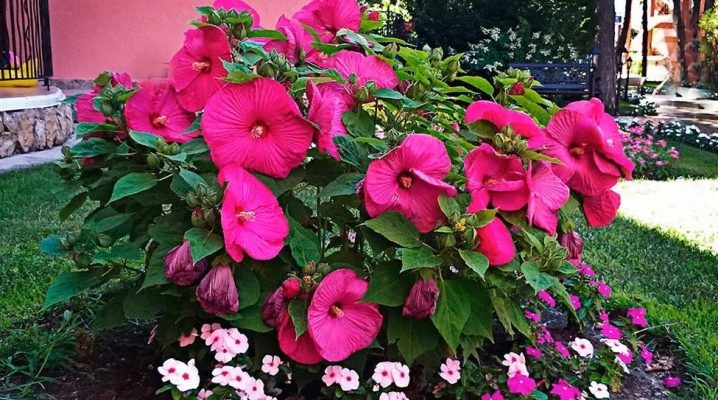
Herbaceous (hybrid) hibiscus adorns the landscaping of many gardeners' sites. The rich color palette of various varieties of garden herbaceous hibiscus allows you to choose plants for planting on your site for every taste. This exotic plant with huge flowers will not leave indifferent the most discerning connoisseur of landscape compositions, will delight with long-term flowering, will add positive emotions and will certainly delight the magnificent view of not only your guests, but also neighbors, as well as casual passers-by.

Description
Herb hibiscus is a perennial plant of the Malvov family, a hybrid of three American varieties: marsh, red and holly (hence the second name is hybrid). It has a well-developed root system with a depth of 20-40 cm. This depth allows the closed root system to safely survive the summer drought and winter cold.
The aerial part of the hibiscus is tall, thick stems, covered with large light green or dark green foliage of various shapes (depending on the variety). In autumn, the aerial part is completely removed, and the root system is covered for the winter. In the spring, with the onset of the warm season, hibiscus grows back from stubbornly overwintered powerful rhizomes, starting the next development cycle with new strong shoots.
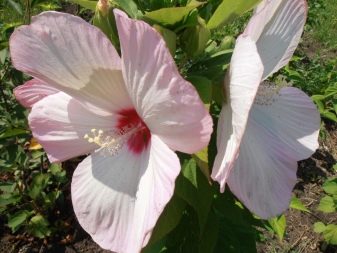
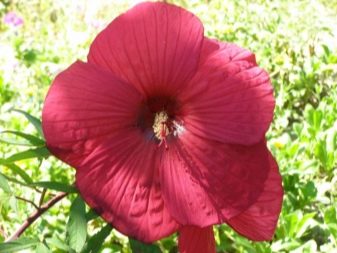
In mid-latitudes, hibiscus blooms in mid-summer, and in more southern regions in early spring. Flowers in structure in various varieties are simple, double and corrugated. An interesting feature of herbaceous hibiscus flowering is that a single flower lives only 1 day, but another flower will certainly bloom to replace it, thus creating the appearance of continuous flowering.
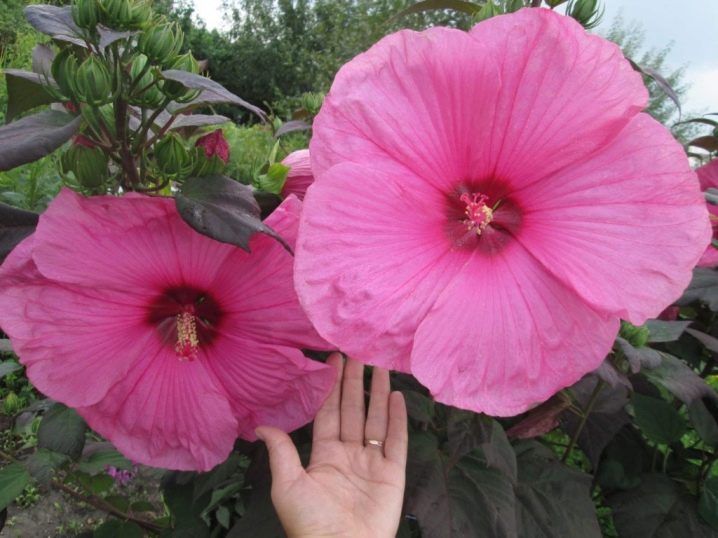
Fragrant flowering shoots will remain on the herbaceous hibiscus until the frost begins. The plant blooms with very large flowers of various shades of the spectrum. Herbaceous hibiscus is a fruiting plant. Its fruits are "boxes" in which the seeds are formed.
Varieties
Among the modern varieties of herb hibiscus, you can find plants with various decorative properties (flower size, color, bush height) to create bright unusual landscape design compositions. The most widespread varieties are Youth, Late, Porcelain Pink, Copper King, Old Yella, Crenberry Crash.
It is possible to list the existing varieties of herbaceous hibiscus for a very long time, and a description of their botanical characteristics and decorative properties will take more than one hundred pages. But each of them is worthy of the attention of both ordinary gardeners and landscape designers.
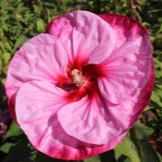
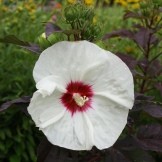
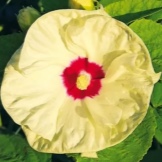
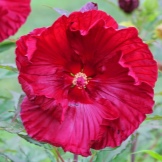
Landing
Before planting, familiarize yourself with the procedure and prepare as necessary. Take full responsibility when choosing a planting site - this affects the full development of the seedling, the speed of growth and the intensity of flowering. The site must be under sunlight for at least 6 hours a day. You can plant hibiscus in open areas, but then you will have to water it much more often. Choose an area with low elevation and sufficient drainage - in hibiscus, with stagnant groundwater, the roots will inevitably begin to rot.

The soil in the selected area is cleared of weeds and dug deeply (at least two bayonets of a shovel).This depth is necessary for the full development of the root system. Herbaceous hibiscus is not very picky about the type of soil and thrives on loam and sod, but the soil should be loose and moisture-permeable.
Herb hibiscus seedlings (grown independently or purchased from a store) can be placed in open ground in the spring, when the probability of recurrent frosts has already passed. If you plan to plant several plants - mark the selected area and allocate enough space for each seedling (1-1.5 m in diameter).
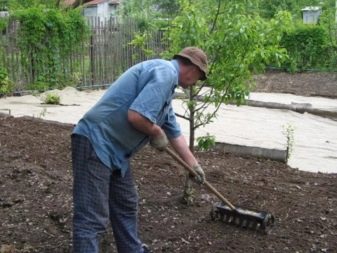
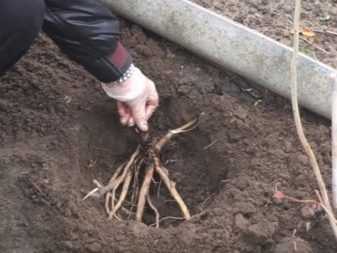
Prepare the planting holes - dig them of the required size, sufficient for the development of roots, add drainage to the bottom (fine gravel, pebbles, brick chips). Mix the soil selected from the pit with peat, humus and sand, sprinkle it a little on the drainage layer. Water the prepared seedlings abundantly, let the water soak well and carefully remove the plants from their "temporary home". Place the seedlings in the pits along with an earthen clod, watch the location of the root collar - it should be slightly below ground level.
Fill the hole with soil mixture, carefully compacting the soil and avoiding voids, mulch the near-trunk zone. The best material for mulch is fallen pine needles.
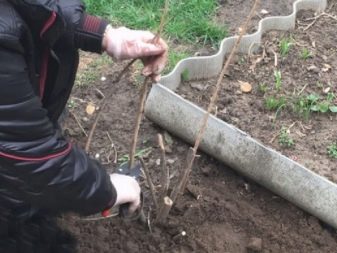
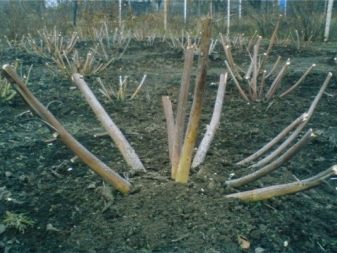
Care
To grow a healthy strong herb hibiscus bush, you do not need to perform any super tasks. You need the usual uncomplicated care - regular watering, weed removal, proper feeding.
Watering herbaceous hibiscus should regularly, while water must penetrate to the depth of the entire root ballso that the roots can extract moisture from the deep layers of the soil. The lack of watering is indicated by the state of the leaves - they will immediately begin to look drooping. On hot days it is good to "pamper" the plants with a summer shower, but only at the end of the day, when the sun is already dropping to set, so that the leaves do not get sunburn.
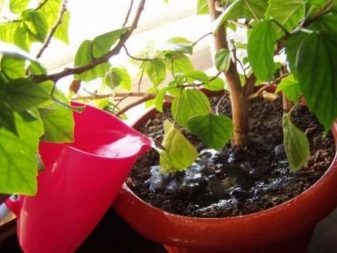
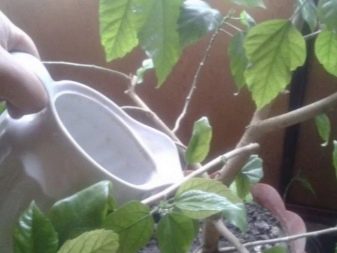
Loosening the soil should be done with extreme caution - the upper sections of the root system are shallow - eliminate the risk of damage to the roots as much as possible. It is recommended to feed hibiscus monthly with nitrates and phosphates, you can also use complex fertilizers. If there is a strong heat - refrain from applying fertilizers under the root - it is better to spray the nutrient solution over the green crown.
With the approach of autumn, potash fertilizers are applied. By the end of the season, feeding stops, the period of preparation for winter begins.
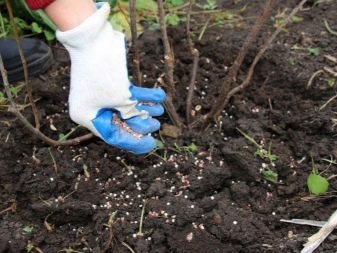
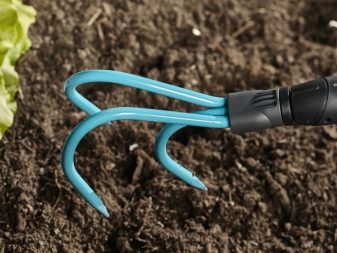
Herbaceous hibiscus have their own characteristics of care - the climate of the middle latitudes requires winter shelters for these plants. The above-ground part of them dies off in the fall and is completely cut out. Do not rush with pruning, wait until the green shoots are completely dry, so that the root system has time to completely take up nutrient resources from the aboveground part, thereby ensuring a successful wintering of the plant.
After removing dry shoots, the rhizome zone is watered, sprinkled a little and sprinkled with humus or mulch (sawdust, fallen leaves, dry needles). For better protection from cold weather, this mound must be covered with a covering material from above and secured against gusts of wind (put boards, stones, branches or something else like that on the sides), you can sketch spruce branches. In the spring, when the threat of frost has passed, carefully remove the shelter, trying not to touch the buds of a plant that is already awakening after "hibernation".
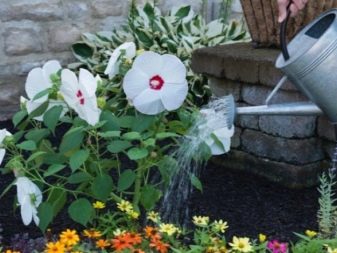
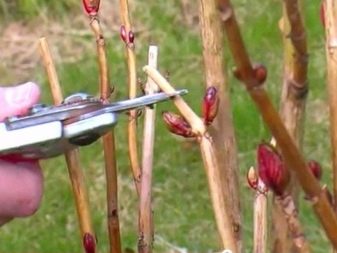
Reproduction
Propagation of herb hibiscus can be carried out in three ways: by seeds, cuttings and dividing the bushes.
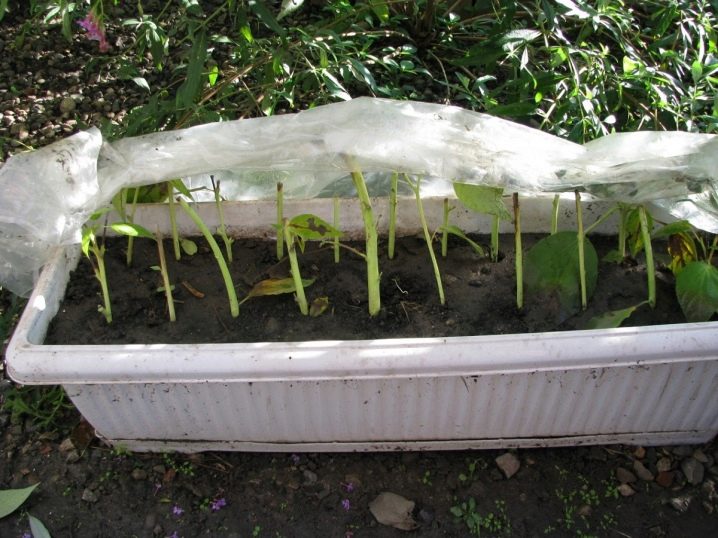
Seeds
Breeders work with this method of breeding when developing new varieties. With the collected seeds, which are planned to be used for sowing, stratification is carried out in a container way. To do this, they are placed in a moistened mixture of sawdust, moss, peat and kept at a temperature of 4-5 degrees for 3-4 months (At home, this can be done by placing the container of seeds in the vegetable compartment of the refrigerator).
The optimal start date for the procedure is January (the deadline is March). After stratification, the seeds are wrapped in a damp cloth and left to swell for about a week, periodically wetting the cloth as it dries.
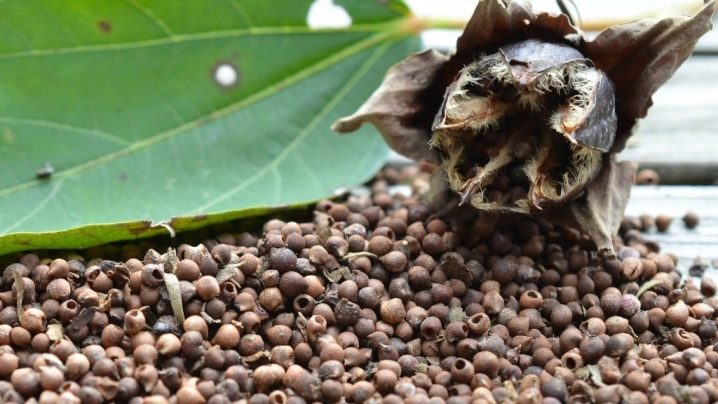
Finished seeds are laid out in a container with soil mixture, it is recommended to sow them at a distance of 0.5 cm from each other. Then the crops are sprinkled with soil and carefully watered from a spray bottle. The seeding depth is 1-2 cm. The container is covered with glass (or other transparent material) and placed in a warm place with good illumination. The first shoots should be expected no earlier than 3 weeks later.
When the first pair of leaves appears, the seedlings dive into separate peat pots filled with a mixture of peat and sand. Planting in open ground should be carried out at the end of May directly in pots (the peat pot will quickly collapse and turn into soil components). The flowering phase of new herb hibiscus bushes will begin 3-4 years after the seedlings are planted in a permanent place in the garden.
Seed reproduction has a significant drawback - new hibiscuses are not always able to accurately reproduce the botanical characteristics of their "parents" and may have the most unpredictable decorative properties. Do not be too upset - you can always choose the most beautiful of the specimens obtained and leave them for further breeding, and your painstaking work will never be in vain.
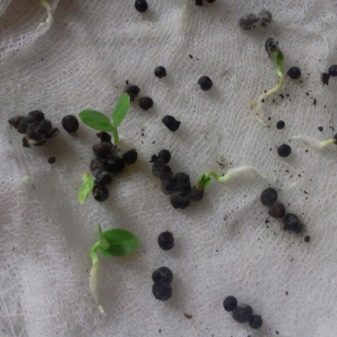
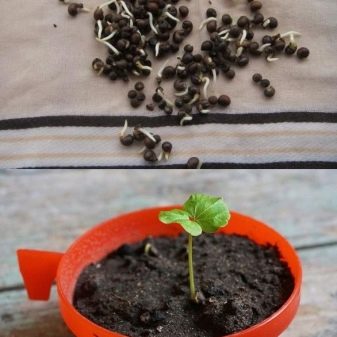
By cuttings
In the fall, a strong, healthy twig of hibiscus is chosen in the upper part of the crown, carefully cut at an angle, the lower leaves are removed and placed in water. Drainage, soil mixture are laid in a spacious container and watered well. After waiting for the water to be absorbed, make small depressions in the soil (about 5 cm). Cuttings are placed in these "holes", lightly sprinkled with earth in a circle, carefully compacted and watered again. The container with plantings is placed in a warm place with sufficient lighting, avoiding direct sunlight.
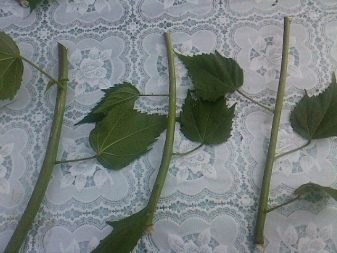
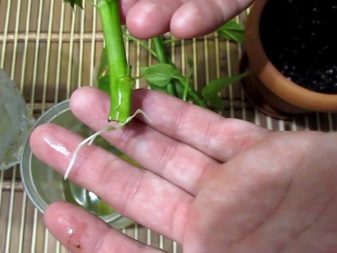
After a month, root formation can be monitored. To do this, very carefully, with minimal effort, you need to pull up the cutting - if the process of formation of the root system is successful, the roots will prevent the seedling from being removed from the soil. The next year after planting the hibiscus to a permanent place under favorable conditions and proper care, the plant should bloom
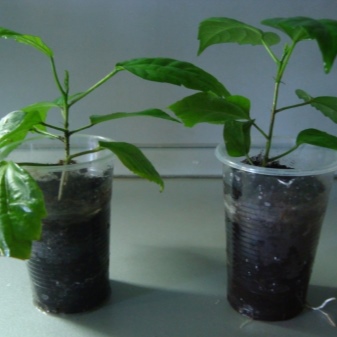
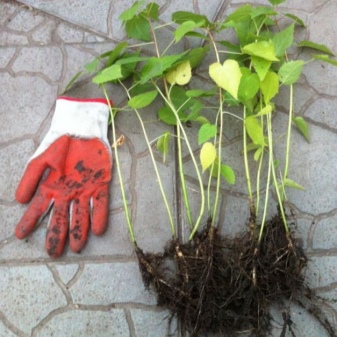
By dividing the bushes
This procedure can only be carried out in springtime and only with mature, well-formed, strong garden hibiscus bushes. In this case, after wintering, the bush is dug out of the ground, the rhizomes are cut and planted in previously prepared places. Previously, fresh sections must be sprinkled with wood ash to eliminate the risk of root rot. With this method, all biological characteristics of the "mother" plant are guaranteed to be preserved.
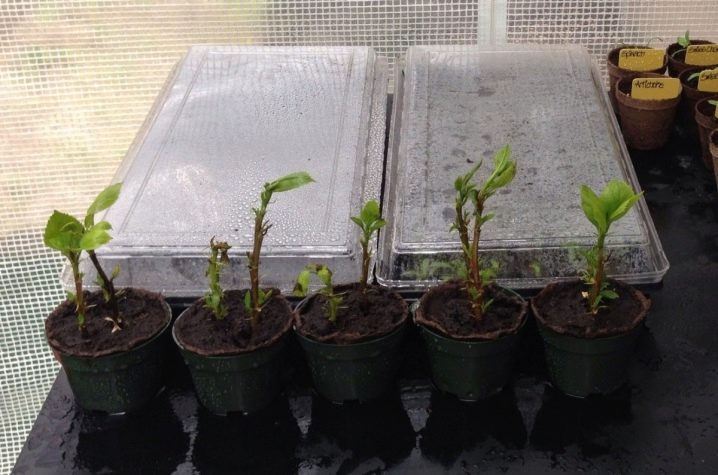
Pests and diseases
Insect pests can attack herbaceous hibiscus: spider mites, thrips, aphids, whiteflies. If pests are found, immediate measures should be taken, because leaf-eating pests can cause serious damage to plants in a matter of hours.
It has been noticed that planting lavender drives away pests. If the climate permits, plant lavender bushes around the hibiscus.

If there are few insects, you can try to get rid of them with folk remedies, for example, spray with herbal infusion of yarrow, calendula, nettle, dandelion, celandine. You can prepare a solution from boiled dry mustard or dry red pepper. In case of massive accumulations of insects, chemical insecticides will have to be applied.
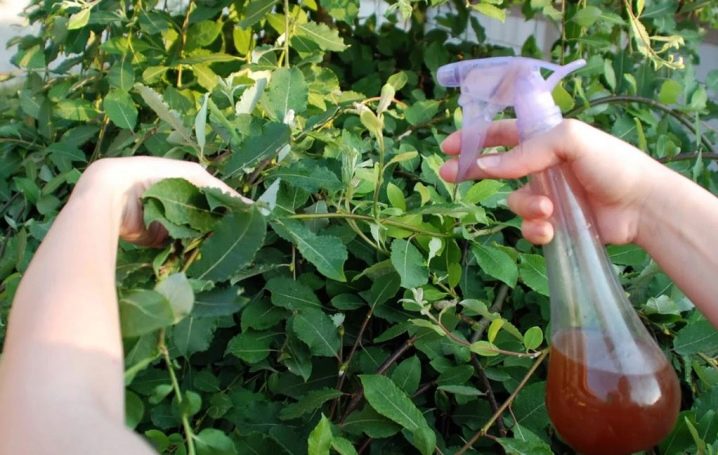
Of the diseases, herbaceous hibiscus is most often affected by chlorosis. A sign of chlorosis is the dropping of the lower leaves on the plant, and new leaves grow slowly and have an unhealthy appearance (yellowish tint).This occurs when there is a lack of nitrogen and iron in the nutrition of plants. For prevention, it is necessary to add iron chelate to the water when watering and feed the hibiscus with complex fertilizers and microelements.
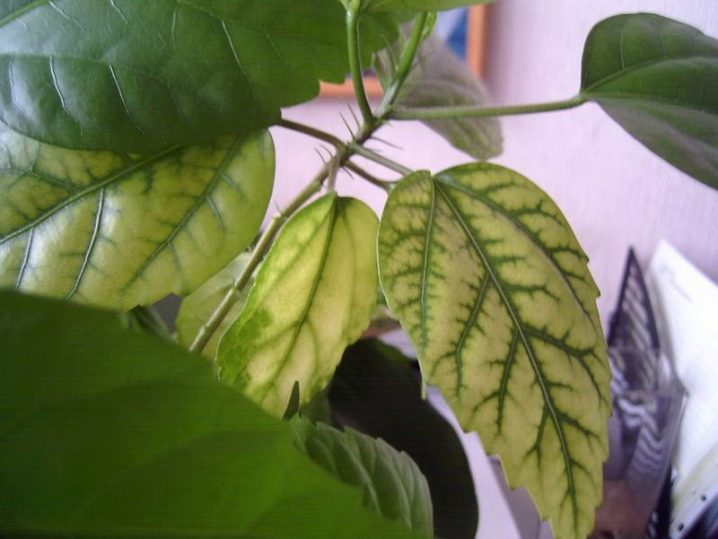
With the cultivation of hibiscus in gardens and dwellings, many signs and beliefs are associated, and often directly opposite. Eastern peoples love and revere this plant, call it the flower of love, consider it magical, carrying positive energy into the surrounding space.
In Europe, among superstitious people, there is an opinion that this is a flower of discord for family relationships, a harbinger of troubles and failures. However, many modern Europeans are very far from superstition, they safely grow hibiscus on their plots and enjoy the fragrant beauty of these wonderful creations of nature with pleasure.

For information on how to properly care for herb hibiscus, see the next video.




























The comment was sent successfully.